Street Shooting…Wide Open!
By Max Marinucci
When it comes to street shooting, we all know well that Rangefinders (and Leica especially) are in an undisputed domain. It always amazes me to see street shooters walking around Manhattan with huge Canons or Nikons and telephoto lenses. I guess they donʼt have much of a choice since sticking a DSLR in someones face would probably not exactly go unnoticed and may even get you a dirty look or worse. A Leica with a small lens (a 28mm or 35mm are usually a wise choice) with its silent shutter click and non-intrusive look has been the weapon of choice since the the 1940s for many professional and amateur street-shooters, with many memorable shots by famous photojournalists.
The old say in street-shooting world is “f8 and be there”. With a Rangefinder and manual focus, catching that fleeting moment can be a little more difficult but, with your camera set @ f8 and using zone focus, one can easily concentrate on quickly composing and snapping away. It is also key here to practice your distances. I usually set my lens so that everything between 10 and 15 feet is in reasonable focus @ f8 and, with practice, I have learned to estimate those distances without any issues.
Having said that, I am a man who loves challenges and the look of certain lenses shot wide open. The king in this regard, in my opinion, is still the Noctilux Classic f1. No, it is not a “almost perfect” lens as the new Noctilux f0.95 but thatʼs exactly why it is so special. This amazing lens renders outlines, colors, out of focus backgrounds, shadows, like nothing else out there. The only lens that comes close to this type of rendering (in regards to shadows and colors) is the 50mm Summar from the 1930s. The Summitar may be a close second but its rendering is sharper and cleaner.
Make no mistake, the Noctilux is a specialty lens. If you plan to heavily use it @ f2 and beyond, get yourself a 50mm Summicron or even a Summitar for a mere fraction of the price. Its magic resides @ f1 and f1.4 at the most. Some people may say it is a gimmicky lens but trust me, it isnʼt by a long shot. It is a lens that I never get tired of shooting with because of its unique look. Skin tends to glow, outlines are unsharp, and, for this reason, it is one of my very favorite lenses for portraits.
When it comes to street shooting though, we have a few challenges to overcome. First of all, it is not a small lens. You will lose that “nimble” factor you would have with a 28 or 35 Elmarit or the great 35mm Voigtlander Color Skopar. Also, the long focus throw takes a while to adjust to but, with practice, that can easily be overcome and can actually work to oneʼs advantage. Now, street shooting wide open @ f1 with the Noctilux can give some very special results but it is not easy. You may miss a few shots but not as many as you may think, once you practice a bit. One issue to be considered, even with the M9ʼs top shutter speed of 1/4000, is f1 in the middle of a bright day. This is where the Leica shines and DSLRs leave you in the dark (pun intended). On a very bright sunny day I use a B+W six stop ND filter so I am able to use the Noctilux wide open and at speeds between 1/250 and 1/500. Try to do that with a DSLR. With a DSLR, you see
through the lens and slapping a 6 to 10 stops ND in front of it, will render you pretty much blind. But, the good old Leica doesnʼt see through the lens so my finder is as bright as the day. Perfect for wide open street shooting! Depth of field: like Iʼve mentioned above, @ f8 and with a little practice estimating distances, youʼre golden. But, at f1, the Noctilux depth of field is literally razor thin and that means you have to focus on your subject manually, fast and accurately. Thatʼs the way I enjoy shooting this lens but I also have used, successfully, the “walk to me” method for certain situations. That means parking yourself in a suitable spot, set your lens to focus letʼs say, at 15 feet and with your subject moving towards you, snap the shutter when he comes into focus.
Besides the welcoming challenge that I find with this approach to street shooting, the results can truly be special. You can achieve a very 3D look by playing with depth and, with the Noctilux way to render shadows (darker and less defined), black & white processing is quite gorgeous. In the color department, and with minimal post processing, I also like the way the Noctilux renders: subtle, not overblown, good, natural skin tones and that wonderful glow that no other lens in the world quite has.
All of the following were shot with the M9 and the Noctilux @ f1. Interestingly, the Exif data for those shot with the ND filter are screwy and recorded @ f11. I guess the filter throws something off and I am not sure of why. Also, Lightroom keeps giving me f1.2 or f1.4 for everything shot @ f1 so something needs to be fixed there. Most where converted to b&w with Nik Silver Efex Pro while Iʼve also shot a few straight with Leica b&w onboard JPG which can be fantastic. Frankly, Iʼd be happy to use the M9 as a b&w only camera with the onboard JPG. With minimal post processing, it gives great looks. Also, it goes without saying that you donʼt need a Noctilux to attempt this. The Voigtlander Nokton 1.5 comes to mind and it would be a perfect lens to have fun with at a fraction of the cost. Nothing will give that Noctilux Classic look @ f1 but that should not preclude anyone to get out there and have fun street shooting…wide open!
This was shot by focusing on a nearby window at about 10 feet and snapped from the hip when the subjects approached the set range
This is another hip shot by zone focusing at about 10 feet and estimating distance from camera to subject.
This obviously required a quick draw and focusing. I saw the scene as nice 3D situation by focusing on the subject on the phone at an angle that I know would render an interesting depth with the bright pedestrian lines and background subjects. With little post processing in slight darkening of the left and right, there is an interesting and pleasing sense of depth.
Same as above, this required some quick thinking and focusing, as I wanted to catch the three main subjects while they were all on the phone. Again, with the out of focus detail, a nice sense of depth is achieved.
Shot while walking right behind the subjects and moving, correct focus was achieved by maintaing the same distance and snapping at the right moment. Again, great isolation and blurring of the background.
Quick turnaround shot of my lovely wife and smiling daughter in the background.
For more examples, visit my Flickr page @ http://www.flickr.com/photos/leicaman/sets/ 72157623763960544/

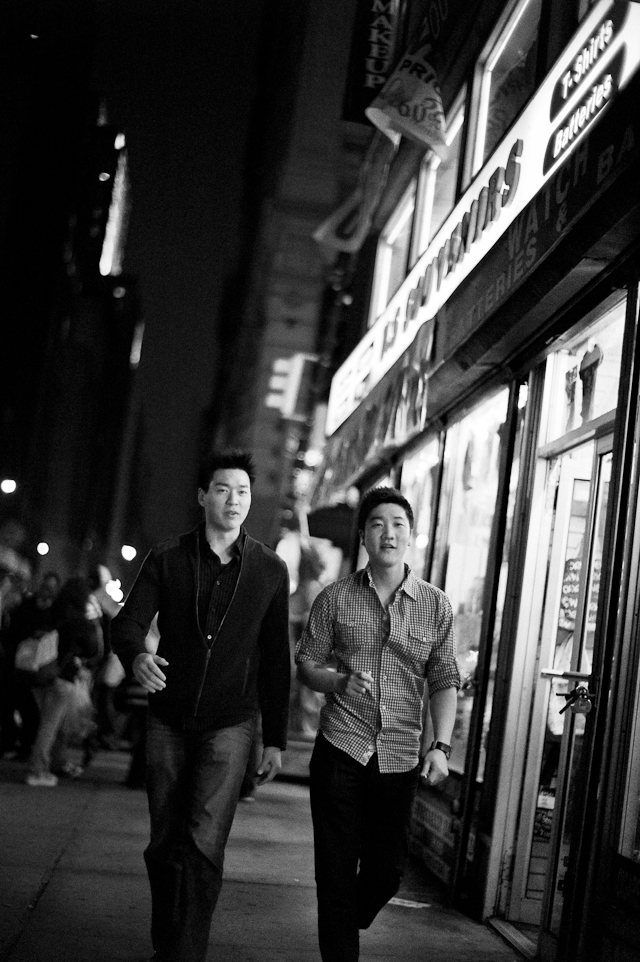
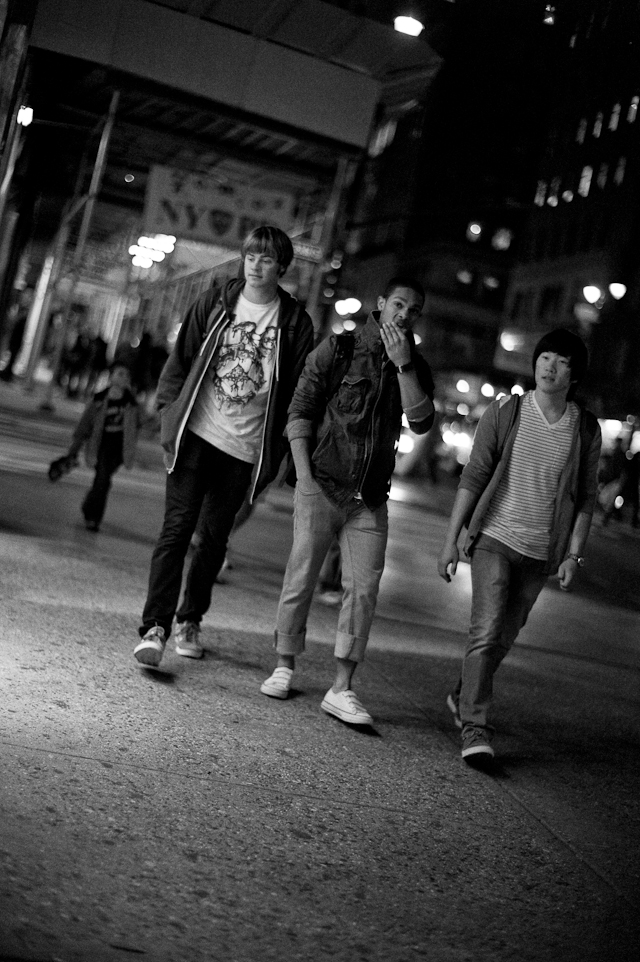
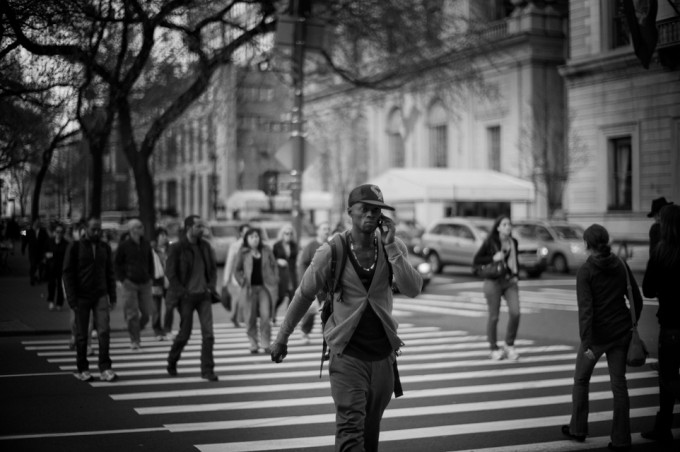
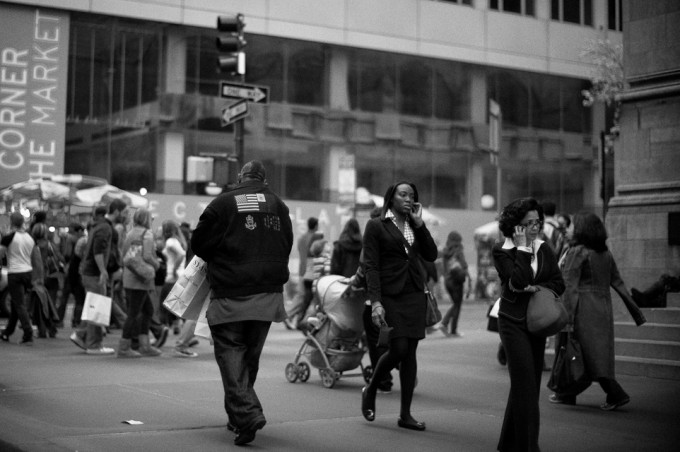
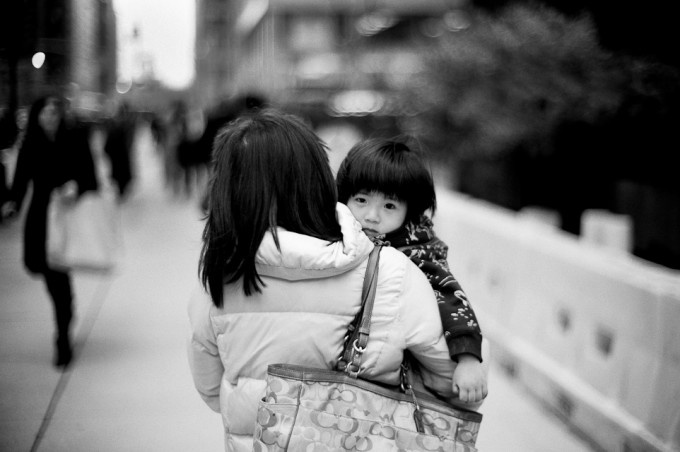
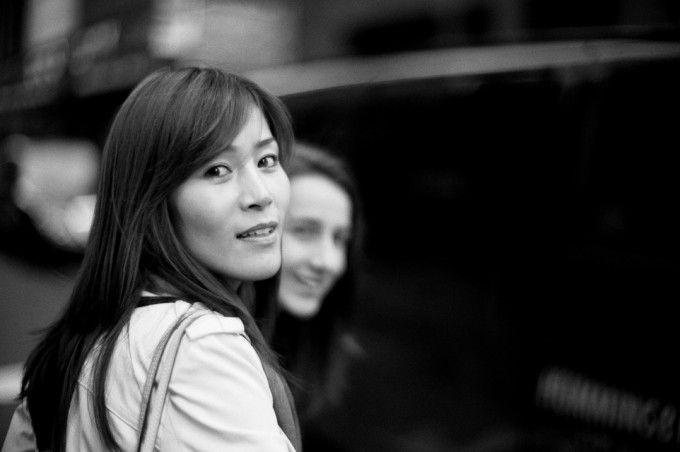


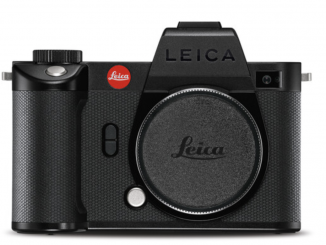
Great article Max,
great pictures too !
Reading this thread made me dig out recent pics I shot similarly from the hip with a GH1 and a Angie 25 @ t1.4 and a Lumix 20 @ f1.7 (w/AF) 🙂
I always found a single “normal” lens encourages you to compose better in 2d and 3d .
Gotta use the good old Lubitel 166 again !
[img]http://www.flickr.com/photos/21905980@N05/5818214080/in/photostream[/img][img]http://www.flickr.com/photos/21905980@N05/5817577329/in/photostream/[/img]
Sorry this was wrong. (Can I delete it?)
Here it is:
http://rafimoor.com/english/bokehe.htm
My explanation:
ftp://rafimoor.com/public_html
[img]http://farm3.static.flickr.com/2775/4452086627_bc05b2fa64.jpg[/img]
Here is the Oxfordstreet one again!
[img][/img]
Great article Max. I was on a trip the last week or so and missed this! So glad a had time today to go through the posts that came up while I was away. Just to add to what you said about the ‘walk to me’ focusing. I also do that and will have the lens at 1.4 and pre-focus on a pole or something in a good stop and wait for a subject to walk past and then I grab it! The first pic below is an example of that. The second is one I shot at about 1.4 but just looked up, saw the guy, focused on him as he was walking past and fired! I got lucky.
Chinatown, London, UK
[img]http://farm4.static.flickr.com/3312/4624967419_056d3a961e.jpg[/img]
Late night, Oxford Street, London, UK
http://farm3.static.flickr.com/2775/4452086627_bc05b2fa64.jpg
Thanks a lot for this article and all the nice tips on how to shoot at that aperture !
However:
“In a very bright sunny day I use a B+W six stop ND filter so I am able to use the Noctilux wide open and at speeds between 1/250 and 1/500. Try to do that with a DSLR. With a DSLR, you see through the lens and slapping a 6 to 10 stops ND in front of it, will render you pretty much blind.”
I’m sorry that’s not correct. Speeds between 1/250 and 1/500 means there is still plenty of light going through the combo lens+filter, enough for the eye to see through a DSLR viewfinder.
Hi Richard,
You are correct and this debate seems to lead to vague generalizations that only lead to confusion.
The way I see it, these are the facts:
The M9 is ONE digital camera. One with very tight focus tolerances (and that is why so many people are sending all their lenses in to Leica with the M9 to be properly coupled) and with a Kodak CCD sensor that, like all sensors, have a linear response and which “demands” a certain approach and care to deliver proper results. I don’t view any of this as a positive but that’s the way it is.
All Leica film cameras can obviously use different film stocks which can give a variety of looks depending on proper exposure, various techniques, filtering, and the inherent qualities of the emulsion itself. A lot more variables, obviously, and all of them have to be considered BEFORE releasing that shutter (which is not the case with the M9 since, focusing issues aside, any mistake not involving wildly blown highlights can easily be fixed later, along with all the other possible corrections). Now, if we are comparing cameras simply as machines/tools, the argument does not stand either. A film Leica is WAY easier to shoot than the M9. Any demand will simply arise once you load it with film and have to make decisions before snapping that shutter, while knowing that you’re stuck with the results…good and/or bad ones.
Wow…how did this turn into another digital vs film debate? Or is it just M9 vs film?…time to go to bed 🙂
I can list a demanding film.
Portra 160 NC.
A negative film – a concept long lauded for being forging in exposure range. This film can’t handle even 1/3 of a stop under exposure before it looks like ASA 800 film pushed to 1600. I learnt this when I dropped my exposure by 1/3 and 2/3 to get more colour and oomph into a sunset shot (a very basic technique for digital and film alike)…. horrible mottling in the blue sky areas made the shots ugly as hell.
Provia 400X is advertised by Fuji as being able to be pushed 2 stops. But compare that to Pro 400H pushed two stops and the provia at 2-3X the cost is a dog.
Again – if a debate is going to revolve around generalisations and then semantic back flips. Why bother?
Okay, Harald, you can substitute “demanding” where I have mistakenly wrote “difficult”. I still do not agree with the “generalization” that film is a lot more forgiving than digital, even if only because digital offers plenty of opportunities for post processing fixes that film just doesn’t give you (and this is blatantly evident when shooting transparencies).
@ Harald
Please do stop misrepresenting myself and yourself post facto. For starters in this context – demanding and difficult are the same thing. Not the time to play semantics.
As to spot metering you know full well what I am referring to. I am not going into the incidence/reflective debate here. I am talking about spot metering, the ability to select a small area and take precise readings off of that as opposed to centre weighted or fancy matrix metering.
You made a statement, people disagree, defend your statement – don’t start playing semantic games with Max and I.
Cheers,
RF.
I never used the word ‘difficult’. The M9 is not a difficult camera at all. There’s a huge difference between difficult and demanding.
Harald,
I guess I just view this differently than you (or Constantine Manos). The fact that the M9 may be a more difficult camera is not necessarily a good thing. For what it does, it really should not be. If the sensor’s linear response is giving people a hard time, or focus tolerances are much narrower (and they are), I view those as flaws, not benefits. Like I’ve said above, if I want challenges, I will shoot a great medium format camera and get quality that blows the M9 away. Again, I don’t have problems exposing with the M9 but it does certainly require more care, which, considering the final results, may or may not be worth it to the shooter. Not ALL film is more forgiving than ALL digitals and we’re strictly talking about the M9 here. Whether the M9s benefits and shortcoming are worth it when compared to film cameras, are simply up to the photographer to decide.
@ Max
I was talking about this last week with Constantine Manos. He just switched from film Leicas to the M9. He actually was the one who brought it up in our conversation that the M9 is a lot more demanding camera than any film Leica. In his words, one needs to be way more precise, in terms of exposure and focus. Film is a lot more forgiving than digital.
I do agree with him.
PS: If you’re having trouble with blown highlights on the M9 (or M8 for that matter) than you are doing something wrong.
@ Richard
Spot meter? Are you kidding me?
There are no spot meters in any camera. Period.
All that camera meters do (any camera) is reflective metering!
You nailed it Max.
I shot a friends wedding this past weekend with E100G in 120 format in my Fuji GA645i. It was golden hour and the contrast was bad at times. I had to time my shots for when the lighting would be even, and then KNOW MY ZONES, so I could pick the best place to stick the meter spot and lock exposure before shutter release.
If I had a digicam, I’d put it on Matrix mode and forget. If it was negative or BW film, I’d just trust in the centre weighted meter. But slide film in that light. No way. Need to work extra hard. That is NOT A GOOD THING. But those chromes will bear witness to my diligence – for eternity. 😉
Harald,
I don’t have problems getting good exposures with the M9 at all and I don’t agree that the M9 is more demanding than film. Sensors have a linear response and blown highlights, especially with the M9, are the norm. But, as you know, unless you really botched exposure, you can recover most in post processing. With transparencies, there is no going back so you either nail it, or you don’t. Kodachrome, for example, gives you 8 stops of dynamic range and unless you hit that sweet spot, you’re out of luck, even though you may have a gentler curve, unlike digital. With a Tech Pan emulsion such as Rollei ATP 1.1 you have to be even more careful, as there is even less latitude.
I personally don’t view the notion that the M9 is a mode demanding camera as a good thing at all.
If I really want challenges and unbeatable quality, I go shoot a Contax 645 loaded with Velvia.
@ Harald.
I would say it is the lack of a decent spot meter on the M9. You can’t shoot zone system without one. The fact is – is that the technology by your own admission has made it more difficult to shoot well. So why would one use it?
Guess, you guys just don’t know how to shoot digitally and get good exposures. Digital and in particular the M9 is a lot more demanding and unforgiving than film.
Richard,
Great points there. I still shoot plenty of transparencies because I like the added challenge of limited exposure latitude along with the rewards when that exposure is nailed. The “Painting With Light” series posted on Flickr would have probably been a disaster had I shot it with the M9. It was a gorgeous, windy late afternoon and thet light was changing constantly and quickly. A took a few meter readings with my Pentax spot meter and knew exactly where I needed to be. I spent those few minutes composing, with some bracketing, and shot away instead of worrying about reviewing each shot for the customary blown highlights and underexposed shadows had I shot with the M9 (or any DSLR). Yes, any mistake certainly sinks in and one has a better understanding of what needs to be corrected. The digital darkroom capabilities when shooting film is another concept that few understand and, as you’ve mentioned, can be put to great use. I tend to pull much of my development for slightly lower contrast because I know that I can just add it later, along with the required dodging and burning to finish an image. Same for color negs, as saturation can be added to punch neutral stocks such as Portra NC.
Film vs digital again…ouch 🙂
RE Film choice – the other major factor is output. In the past slide film was preferred as it is easy to look at. Today however I would seldom us it. It is much like digital and has problems in contrasty light and less than perfect exposures that come with contrasty light.
I do use positive film in 120 though, as I don’t have a good 120 scanner and thus I like to proof on my light table before going to the lab.
With digital processing these days, you don’t have to have a APX100 film to get high contrast, you cn shoot a low contrast film like Neopan Acros and add contrast later. Ditto for saturation added to Portra NC or Astia.
One thing that hasn’t been mentioned with all the right film for the right time and endless choice in post production is serendipity. Happy accidents and twists of fate can make for awesome images. Be it the wrong film, forgetting which film wrong processing, wrong camera setting. I like the added entropy that comes with the territory. 😉
And trial and error is a great way to learn. And doing “review” 2 seconds after capture results in a lack of understanding in what and how is wrong – as you automatically adjust and re shoot. However doing all your “Capture” and just “Moving along” without stopping and then doing one’s “Review” later means that mistake are reviewed better and sink in better, dissappointment at a mess up creates a better learning experience and as a general rule the iterative process is better with cap, cap, cap, cap, cap…………………rev, rev,rev,rev,rev. Than say cap,rev,cap,rev,cap,rev,cap,rev.
Cheers,
RF.
Hi Garon,
Digital post processing is an art in itself and one that requires, time, skills and dedication. I have personally given up on trying to make digital files look like film. Yes, Nik Software does a great job with Color Efex, etc but they are approximations. In my view, a digital file always looks..digital. You may approximate color profiles or add grain, etc but it’s not quite the same. Interestingly, Nik does not have filters for Velvia 50 or Kodachrome 25 in their software. One has to wonder why. It’s just not a look can be achieved by software means, I would guess. For black & white, digital conversions can be okay, as there is less to deal with, although there again I find more differences than similarities.
Yes, as you say, there is the convenience factor of digital and that is not to be underestimated. Maybe that’s why when I shoot film I carry three bodies with different film stocks? 🙂 Good labs have disappeared and it takes a bit of work to get film processed by pros, but it can still be done, thankfully. I would to see this as another digital vs film argument, because it clearly should not be. Both have advantages and disadvantages, with different looks for different needs. They can coexist (I shoot my M9 but I prefer my M3) and it’s all a personal preference.
Spielberg and film? Yeah, he’d probably still say the same thing. Film is still king in cinematography
http://motion.kodak.com/US/en/motion/Products/Customer_Testimonials/index.htm
Hi Elaine,
Happy to hear you’ve enjoyed it. Trust me, you’re doing more than fine with the Summicron, as it is one the very best (if not THE greatest) lenses ever, by anyone. It may not give you the Noctilux look @ f1 but it more than makes up for it at other apertures. As far as film choices, that is a matter of taste. If you chose to shoot exclusively @ f2 in the middle of a bright sunny day, you will have a problem with 400 film and will likely need a 10 stops ND to deal with the film Ms top shutter speed of 1/1000. You can use Ilford PanF (50ISO) and you’ll probably be okay with a .9 ND (6 stops). You will need to experiment a bit, which you can do with your M6 since it meters through the lens. Also, with slower film, you’re giving up grain so it really depends on the look you want to achieve. Lots of possibilities, which can make it confusing but, don’t give up. Trying new things is part of the fun 🙂
Hi Max
I do see what you are saying and I don’t disagree with it. Each film has it’s own unique look and personality and the results are very good however, I personally can take an M9 image and make it look like any film I want. Instead of choosing one film and being forced to only it’s personality, with the M9 I have every film at my disposal along with the unmatched optics and range finder qualities of the Leica system. Film is wonderful if you always have the right one on hand. I’ve been in dozens of situations where Tri-X would have been the optimal film but all I had was Portra 160NC. The same holds true for Velvia, TMZ, Agfa Pan 25, Kodachrome, and many other great films. The other issue and one that is becoming more and more a problem, is proper processing. Drug stores and Costco’s are not the places to have film processed but they are the places people go to more and more often. Unfortunately, many of the great labs are no longer around. Film is definitely the right choice for many people however, I read an article a few years ago where Steven Spielberg said he would only make movies on film and would never go to digital. I wonder if would make the same statement today?
Garon
Harald,
That’s true..pros get paid to be “correct”, I guess (although that is debatable since art is seldom “correct” and that’s the inherent beauty of it, unless you are a wedding photographer). But, since I am not a pro, I do what I enjoy with no pressure whatsoever and, if others enjoy what they see.. fantastic! I chose Velvia 50 with an 85C in front of it for that shot because I did want the yellows/reds to be more saturated and was not looking for neutrality. Some people find that appealing and others don’t. That’s okay. I am not looking to be “correct” but to achieve something that is pleasing to ME. Again, if others find it as pleasing, wonderful, and if they don’t, that’s okay too.
As far as the Summitar, you won’t find any argument from me there. I still think it is one of the greatest lenses ever made by Leica and I guess more “correct” than the Noctilux in the bokeh department. I personally don’t mind a little swirl from the Nocti at times, which I guess it will never put me in the “greats” category but, since I don’t really aspire to be, it’s all good for me 🙂
Max, Elaine,
First, let’s get a big misconception out of the way. When one shoots film that person chooses a “profile” when purchasing a particular film. With digital one chooses the profile afterwards. Which means, of course the files need a little TLC in post. Period.
Back to film, the difference between amateurs and pros is that the amateur buys the film (profile) he/she likes best no matter what it will be used for. Pros on the other hand pick (picked) the film based on what the assignment called for.
Huge difference. For instance, for the sunrise shot above I would have never picked Fuji. Fuji film is way too yellow. This is very visible in the reds of the tree and that path and a little less in the clouds.
I would have used probably Kodak(*) instead. In opposite to Fuji it is a little on the blue side which would have kept things a little more neutral and to get the sunrise effect in a nice and controlled way some filter would do the trick.
(*not Kodachrome though. Way too saturated colours for this particular task.)
Next. Max, I do have a 50/f2 Summitar as well and its bokey is smooth as a baby’s bottom. No crazy swirls, just a smooth run off into “blurriness”. Yet, without loosing structure!
Yes,you are absolutely right all that is in the eye of the beholder but look at the work of the great’s and you’ll rarely find swirly bokeh. Just a thought.
great article, this is the type of photography I do all the time, wide streets.
just one thing, if you are shooting from the hips, it doesnt matter if you use an rf or an slr, just when you rise the camera to your eyes make the difference, or in small places like interiors, if you are in a big city with crowd its okey even with a mf camera jeje, although shooting a rangefinder is amazingly sweet and beautiful ofcourse
sorry my poor english
regards,
Nacho
Max, thanks for another fine article. I can’t afford the Noctilux lens. Ouch! The other one you mentioned may work, but I like using the two crons I have. Those set me back enough. LOL!
What are the ND filters you use? Do you have a link? I just bought a ND filter for the M6 for when I shoot the Ilford B&W ISO 400 film during the day. I don’t know about ND filters at all, so don’t understand what a B+W six stop ND filter is. Now I wonder what the heck I bought for a ND filter. Yeah, I know. I’m a newbie in regards to the filters. I figured the 1000th shutter limit on the M6 coupled with the 400 film would warrant the ND filter. Just don’t know which one. Now that I know there are levels of filters, I feel kind of stupid in buying one blindly.
In your opinion, what is the best film to shoot in a M6 in regards to speed? I would think 100, but XP2 only comes in 400 speed. Hence the ND filter. (Trying to find the best film. I love the Reala, and converted to B&W it looks fabulous that way too.)
I totally agree with you on the M9 not producing the perfect fil out of camera. I have the M8.2, and though it produces nice files, they do need PP for them to show the true colors and such. I was kind of surprised at that because my cheapo Nikon D80 actually does a better job at correct colors coming out of the camera, but the files aren’t as crisp to me as they are coming out of the Leica M8.2. There is a definite look to the Leica as opposed to the Nikon I have, which I think is more of a dimensional look. Maybe it’s the lenses? Anyway, files out of a digital camera need to be adjusted in color and sharpness at least.
Then again, I noticed the Reala film came back with a slight green cast to them. (I had them placed on disc. That could be the result of the place I had them developed though it was more pro than a Costco or Walgreens.) It could also be that type of film? Not sure. Anyone else have this experience?
Thanks again for the awesome article. i always learn something new when I read your articles.
Harald,
The Noctilux is still a specialty lens that only makes sense at f1 in my opinion, and certainly not for all situations. Yes, it does give that swirly bokeh at times and that is a matter of taste. The old Summitar and Summar are the same and it does not bother me. While technically not correct, bokeh beauty always seems to be in the eye of the beholder so I don’t really sweat it much.
Richard,
I see people doing street shooting with D3 and 300mm lenses in Manhattan, so obviously, to each his own. Everyone has their methods and styles. I have tried with a FM3A but it is just not the same for me. If I want low grain, I need slow film but, on a sunny day, even at 25ISO, you’d probably still need a ND to shoot wide open and that complicates things with an SLR. Again, in general, I find Rangefinders more apt to street shooting but others, such as yourself, do a very fine job with SLRs. Whatever works 🙂
FYI – Nikon FM family bodies are the same size (slightly smaller in fact) than M7’s (so smaller than M9’s for sure) and work just great too for this style of shooting. I am living proof that a ranger finder is not needed or better. Unless of course you need to do IR or start with the ND’s – then yeah it is best. But for 95% of the time people shouldn’t sweat it.
Cool info. Though I have moved beyond those techniques where the issue of subtlety or beng discreet was paramount. In general if you try to hide the camera you will cause more problems than solve.
So use the same techniques – but not to allow shooting from the hip – but ti reduce the time between identification of shot and camera being ready to take it. Then I pounce in. People will see and notice me – but that doesn’t matter. The shot is mine.
If you have only 2 seconds between notice and shot – then the more prep work or “known variables’ that you have in your head about camera setup and the spatial awareness of your surroundings and object – then that 2 seconds is almost too much time. 😉
I do have the Noctilux 50/f1 as well and like it (well, depends on what I do with it).
As nice a bokeh it has it can ruin a shot in my opinion very easily.
Unfortunately, the Nocti f1 has – depending on shooting condition – the tendency to take its bokeh to the extreme and make it kind of swirly-whirly looking. With that comes a total loss of structure and no matter how nice many consider this to be, it pretty much ruins the shot.
One or two of your above shots show those swirls (the last two of your series, the last shot not as bad as the one before). No matter how “nice” everybody things this is, they are in my book wasted.
On a side note, the best work ever done with a Noctilux is shown in a book called “Doctor’s Work – The Legacy of Sir William Osler” by renowned photographer Ted Grant.
All photos in this book were taken with a Noctilux (M6 cameras and from the look probably TriX film). Available light only and sometimes rather “available darkness”, to quote Ted Grant.
None of the photos look like they’ve been taken at f1 whatsoever.
Thanks, Sergey! I see that you are enjoying the “film adventure” and getting great results. Keep having fun, my friend.
Hi Eddie, thanks so much. I do use the 1.4 magnifier on the M9 with lenses from 50mm and up. With wider lenses, it obviously brings the framing lines too close to the edge of the finder so it is not recommended. It does not make a huge difference with the noctilux or any other 50mm but again, it does help focus with longer lenses.
Max:
Thanks.
1. I like to look at your M3/Velvia picture again & again.
2. How about the 1.4X on your Noctilux?
Max, Fantastic article and as always I walk away from reading with yet another “try this” tip, which keeps photography interesting for me. Thanks for all the advice. Looking forward to your next article.
Sergey
Thanks everyone for the kind words and very happy to hear you are enjoying these articles. Thanks, Steve for giving the opportunity to share.
Eddie Ho…YES, I do use the magnifier, especially for longer lenses (90mm and 135mm), as it makes it easier to focus.
Let’s try again for the file..
[img]http://farm5.static.flickr.com/4054/4590040396_da4fe7658f_o.jpg[/img]
Or
http://www.flickr.com/photos/leicaman/4590040396/sizes/o/
Garon,
Sorry, I disagree there. I do love the M9 but to say it gives the film look right out of the camera is just not true. Jpeg mode is downright bad and, when shooting raw, you need extensive post processing to get what film gives you by putting effort into other areas such as lighting and composition. Second, shooting digital and film can coexist peacefully so there is really no reason to cling to one or the other.
Here is an example of Fuji Velvia 50 shot two weeks ago at sunset. I’ve used my 1959 Leica M3, and a 1959 21mm Supern Angulon f4. Processed and scanned by NCPS in California and this is what I get back. Not ONE millisecond of post processing involved! Hate to say it, but there is now way the M9 would have given me this straight out of the camera.
[img][/img]
Max: What is your advise on using the 1.4x magnifier?
Great, informative article. I hope to pick up a used Noctilux one of these days and really long to try out street shooting with it wide open. I figured an ND filter would be a necessity in daylight. I shall tuck this article away for future reference!
One of the many great features of the M9 is that it still can achieve that film look right out of the camera. It’s the only digital camera I’ve found that has this quality. Ironically, M9, and Leica shooters in general, still cling to film. I understand the sentimental reasons, but I don’t understand it from a results only perspective.
Just a thought
Max and Steve, this is a wonderful article and with beautiful photos. I is so great that Steve does such a great job of bring great guests with their skill and experience to add to his great skill and experience. You guys have moved me back to b&w film shootig and home developing which is where I was in 1982. Keep showing us how digital and film are complementary and no exclusive of one another.
Another great article. Really enjoy your guest features Max.
Thanks very much for the advice Max. I can’t wait for the weather to clear up in London and then I’ll spend sometime after work and the weekend exploring these new points of view.
Thank you, Ray, for the kind words. For street shooting in general, (or to shoot from the hip or chest level) practice by estimating distances using various apertures. Just take walk a somewhere, set the camera at f5.6 or f8 with different focus zones. Then estimate distances to your intended focus point and shoot away. With practice, you will learn to estimate well and put it to good use. Obviously, this is where a digital rangefinder becomes a lot more convenient, as you can check your results right away, without wasting film.
Thanks, Rudolph. Interestingly, I get erroneous exif data with the Noctilux even without filters. When used @ f1, it always gives me f1.4. I guess it is something Leica needs to fix.
The ‘erroneous’ EXIF data may be caused by the way the M9 calculates the used aperture. It has no direct info (by electronic link) of the used aperture, only the max aperture with 6-bit coded lenses. The M9 guesses the used aperture by the relative light difference between light through the lens and direct external light. With a dense ND filter that means a low light level through the lens and thus it ‘calculates’ a small aperture. Mr Leica a better explanation?
Awesome article Max. I’ve been following you on Flickr for a while, and love your work. Your photo above of the guy on the phone is one of my all time favourite photographs on Flickr. Beyond the amazing sense of 3D, they all look as if they are floating above the zebra crossing. Truly incredible!
New to photography, I’ve never tried shooting from the hip, but will give it a go!
Walt, actually my M9 is black, fairly beat up already and I cover all the logos. Pretty stealth and, also, to use a 6-10 stops ND filter on a SLR to shoot wide open with a fast lens during the day means that you can’t see anything through the lens.
My personal experience is that I got some great results shooting from the hip with a d40 and 35mm f1.8. I must say though it’s easier to shoot kids/pets (looking down).
[img]http://www.flickr.com/photos/22570099@N06/4383227857/[/img]
Feel a little perverted when shooting up though…feels like shooting up a girl’s skirt!
I’d be far more amazed by a streetshooter walking around with a shiny M9 & Noctilux than with an SLR which is so ubiquitous nowadays that nobody gives a hoot.
That’s interesting and it gives a 3D feeling to these street shots, which I consider normally as very flat.
Congrats !